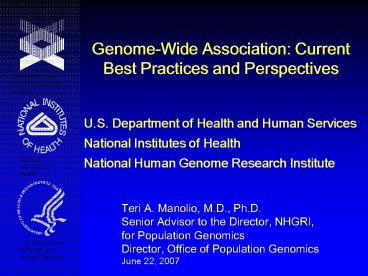Genome-Wide Association: Current Best Practices and Perspectives - PowerPoint PPT Presentation
1 / 16
Title:
Genome-Wide Association: Current Best Practices and Perspectives
Description:
Genome-Wide Association: Current Best Practices and Perspectives ... Current smoker. 4.23 [2.86-6.27] 1.95 [1.41-2.71] 1.00. Non-smoker. 12.28 [4.88-30.90] ... – PowerPoint PPT presentation
Number of Views:26
Avg rating:3.0/5.0
Title: Genome-Wide Association: Current Best Practices and Perspectives
1
Genome-Wide Association Current Best Practices
and Perspectives
National Human Genome Research Institute
U.S. Department of Health and Human
Services National Institutes of Health National
Human Genome Research Institute
National Institutes of Health
Teri A. Manolio, M.D., Ph.D.Senior Advisor to
the Director, NHGRI, for Population
Genomics Director, Office of Population
Genomics June 22, 2007
U.S. Department of Health and Human Services
2
Perspectives and Best Practices
- Confusing nomenclature is major challenge
- Collaboration is key and can promote careers
- Mechanisms needed for supporting young
investigators - Be sure what models and assumptions used
- Large projects stimulate technology development
and vice versa - Data sharing crucial
- Need repositories of tissues for expression,
function, methylation testing
3
Perspectives and Best Practices
- Current GWA only capturing fraction but still
finding genes, and tools will only get better - Importance of translation VKORC1 and warfarin
- Importance of examining observed vs expected
distributions QQ plots - Importance of handling DNA of cases and controls
similarly - Replication, replication, replication
- CGEMS association data available for instant
replication
4
Perspectives and Best Practices
- Genotype data are not infallible
- Apply QC filters
- Inspect cluster plots
- Critical to know sample type
- CNV exciting, need better detection software
- More SNPs may not be better than more people
- Plan for analysis work with trial datasets
similar to your platform - Most datasets too large for SAS, programs widely
available such as PLINK
5
Perspectives and Best Practices
- Use of genome browsers and annotations
- Unfiltered data can be very informative
- Collaboration getting easier extraction and
genotyping are value added to cohorts - Multiple models of collaborations shared,
complementary, apportioned - dbGaP will accept associations as accessions
and may soon be required by major journals - Documentation and display of study protocols like
AREDS and Framingham are revolutionary
6
Perspectives and Best Practices
- Use of genome browsers and annotations
- Genomics in prospective population studies must
include - participant involvement
- multiple consent provisions
- ethical oversight
- Data sharing should be encouraged and planned in
advance, participants want this - Plan for future approaches expression,
epigenetics, sequencing, all need collaboration - Changing the tenure (granting, award) system will
take a very long time
7
Warm-Up Genotyping Data Sets
- NINDS Open Access Repositoryhttp//ccr.coriell.or
g/ninds/ - Initial genome wide genotyping in Parkinson
disease, stroke, ALS, controls - HapMap Samples on GAIN Platformshttp//www.ncbi.n
lm.nih.gov/sites/entrez
8
Genetic Architecture of Complex Traits
- Number of loci involved
- Frequencies and effects of their alleles
- Type of loci, i.e., structural or regulatory
Boerwinkle and Sing, Ann Hum Genet 1987
51211-26.
9
Epidemiologic Architecture of Genetic Variants
- Population prevalence (allele frequency)
- Prevalence in racial/ethnic subgroups
- Relative risk of rigorously-defined, incident
disease - Consistency of association across subgroups
defined by age, sex, race/ethnicity, or exposures
- Potential modifiability of associated risk
- Correlations with other traits and exposures
10
Rapid Investigation of Genetic Associations in
Population Studies
Develop novel approaches for utilizing existing
prospective cohort studies and clinical trials
to
- Determine population impact of putative risk
variants, including prevalence, disease risk, and
associations with other health characteristics - Identify modifiers of gene-trait associations,
particularly those related to modifiable factors - Identify potential clues to gene function, by
examining associations of putative risk variants
with related phenotypic characteristics such as
laboratory measures or imaging findings
11
P Values of GWA Scan for Age-Related Macular
Degeneration
Klein et al, Science 2005 308385-389.
12
Risk of Developing AMD by CFH Y402H and
Modifiable Risk Factors
Risk Factor CFH Y402H Genotype CFH Y402H Genotype CFH Y402H Genotype
Risk Factor YY YH HH
BMI lt 30 kg/m2 1.00 1.95 1.42-2.67 3.96 2.69-5.82
BMI gt 30 kg/m2 1.98 0.91-4.31 2.19 1.11-4.30 12.28 4.88-30.90
Non-smoker 1.00 1.95 1.41-2.71 4.23 2.86-6.27
Current smoker 2.34 1.20-4.55 3.20 1.85-5.55 8.69 3.86-19.57
Schaumberg DA et al, Arch Ophthalmol 2007
12555-62.
13
Larson, G. The Complete Far Side. 2003.
14
(No Transcript)
15
- The more we find, the more we see, the more we
come to learn. - The more that we explore, the more we shall
return. - Sir Tim Rice, Aida, 2000
16
Lessons Learned from Initial GWA Studies
- This actually works!
- Size matters
- Luck matters
- Replication matters
- Collaboration matters
- Controls matter, but can be shared sometimes
- Non-coding SNPs and gene deserts matter
- Current hypotheses regarding candidate genes and
pathways may not matter so much - Several genes influence more than one disease































